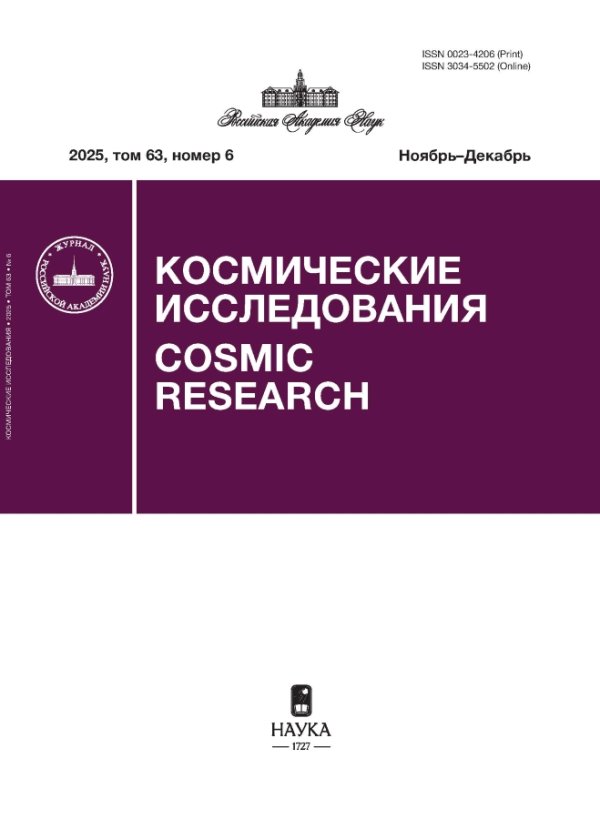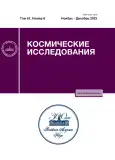Optimization of Solar-Sail Control When a Vehicle Moves along Cyclic Heliocentric Trajectories
- Authors: Rozhkov M.A.1, Starinova O.L.1,2
-
Affiliations:
- Samara University, 443086, Samara, Russia
- Nanjing University of Science and Technology, Nanjing, China
- Issue: Vol 61, No 6 (2023)
- Pages: 510-519
- Section: Articles
- URL: https://journals.rcsi.science/0023-4206/article/view/231827
- DOI: https://doi.org/10.31857/S0023420622600337
- EDN: https://elibrary.ru/BYNDDU
- ID: 231827
Cite item
Full Text
Abstract
This paper considers the problem of constructing time-optimal trajectories for a spacecraft (SC) with a solar sail. The trajectories under consideration consist of repeated cycles of spacecraft movement to the target heliocentric orbit and back to the initial one. A model of a perfectly reflecting sail is used, which allows using the programs for optimal control of the sail angle, obtained on the basis of the Pontryagin maximum principle. The heliocentric motion is modeled in a flat polar coordinate system, and the spacecraft itself makes cyclic flights between two terrestrial planets along a closed trajectory. A boundary-value problem is formulated, in the solution of which the approach of the spacecraft to the target planet with the equalization of velocities is ensured (the encounter problem). Simulations of four cycles of Earth–Mercury–Earth and Earth–Mars–Earth motion with a characteristic acceleration of the solar sail of 0.25 mm/s2 have been carried out, for which the duration of one cycle is on average 2000 and 2341 days, respectively. Optimal sail-orientation control programs are obtained for a wide range of launch dates, and methods of searching for and choosing the initial values of conjugate variables are shown. The obtained results demonstrate the ability of a spacecraft with a solar sail to implement controlled motion along closed trajectories with a minimum duration of individual Earth–destination planet–Earth flights.
About the authors
M. A. Rozhkov
Samara University, 443086, Samara, Russia
Email: rozhkov.ma@ssau.ru
Россия, Самара
O. L. Starinova
Samara University, 443086, Samara, Russia; Nanjing University of Science and Technology, Nanjing, China
Author for correspondence.
Email: rozhkov.ma@ssau.ru
Россия, Самара; Китай, Нанкин
References
- Синявский В.В. Научно-технический задел по ядерному электроракетному межорбитальному буксиру “Геркулес” // Космическая техника и технологии. 2013. № 3. С. 25–45.
- Crusan J.C., Smith R.M., Craig D.A. et al. Deep space gateway concept: Extending human presence into cislunar space // Proc. IEEE Aerospace Conference. 2018. V. 2018-March. https://doi.org/10.1109/AERO.2018.8396541
- Haws T.D., Zimmerman J.S., Fuller M.E. SLS, the Gateway, and a Lunar Outpost in the Early 2030s // Proc. IEEE Aerospace Conference. 2019. V. 2019-March. https://doi.org/10.1109/AERO.2019.8741598
- Поляхова Е.Н. Космический полет с солнечным парусом: проблемы и перспективы. М.: Наука, 1986. 304 с.
- Мельников В.М., Матюшенко И.Н., Чернова Н.А. и др. Проблемы создания в космосе крупногабаритных конструкций // Труды МАИ. 2014. № 78. С. 1–21.
- Mori O., Sawada H., Funase R. et al. First Solar Power Sail Demonstration by IKAROS // Transactions of the Japan Society for Aeronautical and Space Sciences, Aerospace Technology Japan. 2010. V. 8. Iss. 27. P. 25–31. https://doi.org/10.2322/tastj.8.To_4_25
- Spencer D.A., Betts B., Bellardo J.M. et al. The LightSail 2 solar sailing technology demonstration // Advances in Space Research. 2021. V. 67. Iss. 9. P. 2878–2889. https://doi.org/10.1016/j.asr.2020.06.029
- Frisbee R.H. Solar Sails for Mars Cargo Missions // AIP Conference Proc. 2007. V. 374. P. 374–380.
- Hughes G.W., Macdonald M., McInnes C.R. et al. Sample return from mercury and other terrestrial planets using solar sail propulsion // J. Spacecraft and Rockets. 2006. V. 43. Iss. 4. P. 828–835.
- Vergaaij M., Heiligers J. Time-optimal solar sail heteroclinic-like connections for an Earth-Mars cycler // Acta Astronautica. 2018. V. 152. P. 474–485.
- Понтрягин Л.С., Болтянский В.Г., Гамкрелидзе Р.В. и др. Математическая теория оптимальных процессов. М.: Наука, 1969. 393 с.
- Ду Ч., Старинова О.Л. Генерация искусственных гало-орбит в окололунном пространстве с использованием двигателей малой тягой // Косм. исслед. 2022. Т. 60. № 2. С. 151–166. https://doi.org/10.31857/S0023420622020029
- Wright J.L. Space sailing. Gordon and Breach Science Publishers, 1992. 258 p.
- McInnes C.R. Solar sailing: technology, dynamics and mission applications. Springer Berlin, Heidelberg, 2004. 296 p.
- Vulpetti G., Johnson L., Matloff G.L. Solar sails: A novel approach to interplanetary travel // Solar Sails: A Novel Approach to Interplanetary Travel. Springer New York, 2015. 277 p. https://doi.org/10.1007/978-1-4939-0941-4
- Белецкий В.В., Егоров В.А., Ершов В.Г. Анализ траекторий межпланетных полетов с двигателями постоянной мощности // Косм. исслед. 1965. Т. 3. № 4. С. 507–522.
- Ишков С.А., Милокумова О.Л., Салмин В.В. Оптимизация замкнутых межпланетных перелетов Земля – Марс – Земля с малой тягой // Косм. исслед. 1995. Т. 33. № 2. С. 210–219.
- Forward R.L. Grey solar sails // J. the Astronautical Sciences. 1989. V. 38. Iss. 2. P. 161–185.
- Рожков М.А. Влияние оптических характеристик многослойного солнечного паруса на его гелиоцентрическое движение // Вестник Самарского университета. Аэрокосмическая техника, технологии и машиностроение. 2022. Т. 21. № 4. С. 52–65. https://doi.org/10.18287/2541-7533-2022-21-4-52-65
- Жуков А.Н., Лебедев В.Н. Вариационная задача о перелете между гелиоцентрическими круговыми орбитами с помощью солнечного паруса // Косм. исслед. 1964. Т. 2. № 1. С. 46–50.
- Старинова О.Л. Расчет межпланетных перелетов космических аппаратов с малой тягой. Самара: Издательство Самарского научного центра РАН, 2007. 196 с.
- Патент 2022617890. Российская Федерация. Определение оптимального управления движением космического аппарата с электроракетной двигательной установкой, применяя принцип максимума Понтрягина: № 2022613916: заявл. 09.03.2022: опубл. 26.04.2022 / Старинова О.Л., Сергаева Е.А., Рожков М.А.
Supplementary files


















